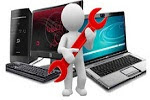10 Suitable definition of Desktop Computer
What is Desktop Computer?
A desktop computer is a personal computer designed for regular use at a single location on or near a desk or table due to its size and power requirements. The most common configuration has a case that houses the power supply, motherboard (a printed circuit board with a microprocessor as the central processing unit (CPU), memory, bus, and other electronic components), disk storage (usually one or more hard disk drives, optical disc drives, and in early models a floppy disk drive); a keyboard and mouse for input; and a computer monitor, speakers, and, often, a printer for output. The case may be oriented horizontally or vertically and placed either underneath, beside, or on top of a desk.
A desktop computer can refer to any user's machine, whether Windows, Mac or Linux or style of case. However, the term "PC" by itself would be more common for this generic usage, and the terms "Windows desktop," "Mac desktop," etc. would be more specific. See desktop computer.
A desktop computer is a client (the user's machine) in contrast to a network server. See desktop computer, client and server.
A desktop computer is a user's computer in a desktop or tower case in contrast to a portable computer. See laptop and tower case.
A desktop computer may refer to a unit that is designed for the top of the desk, such as an all-in-one or a very small case, in contrast to a floor-standing tower. See tower case and All-In-One.
A desktop computer is a client (the user's machine) in contrast to a network server. See desktop computer, client and server.
A desktop computer is a user's computer in a desktop or tower case in contrast to a portable computer. See laptop and tower case.
A desktop computer may refer to a unit that is designed for the top of the desk, such as an all-in-one or a very small case, in contrast to a floor-standing tower. See tower case and All-In-One.
A desktop computer (or desktop PC) is a computer that is designed to stay in a single location. It may be a tower (also known as a system unit) or an all-in-one machine, such as an iMac. Unlike laptops and other portable devices, desktop computers cannot be powered from an internal battery and therefore must remain connected to a wall outlet.
A desktop computer is a personal computer that fits on or under a desk. It typically has a peripheral monitor, keyboard, mouse, and either a horizontal or vertical (tower) form factor. Unlike a laptop, which is portable, a desktop computer is meant to stay at one location.
History of the desktop computer
The earliest computers in the mid-1960s were large and took up entire rooms. Even the smaller computers at the time, known as minicomputers, were at least the size of a desk themselves.
The earliest computers in the mid-1960s were large and took up entire rooms. Even the smaller computers at the time, known as minicomputers, were at least the size of a desk themselves.
The first computer that could be considered a desktop was the Olivetti Programma 101. It was released in 1965 and was the size of a typewriter. Other desktops popped up through the mid-1970s and the first home computers -- TRS-80, Apple II and Commodore Personal Electronic Transactor -- debuted in 1977. Desktop computers became increasingly popular in the subsequent decades with IBM Personal Computer and Apple Macintosh dominating the market.
Most early desktop computers used cathode ray tube (CTR) displays that sat on top of the actual computer, which laid horizontally on the user's desk. These are known as all-in-one desktop computers. Modern desktop computer displays use light-emitting diode (LED), liquid crystal display (LCD) or organic LED (OLED) displays.
In the 1990s, the all-in-one style desktop gave way to computer towers that users could store on the floor under their desks. By moving the processor off the desk itself, users could work with larger monitors. These are known as full-sized desktops, and the tower connects to the monitor and other aspects of the desktop through cables. In more modern desktop computers, the connection can be wireless. There are also compact desktop computers, which are similar to full-sized desktops but in a smaller form factor.
In the 2000s, the desktop computer gained competition in the form of laptops -- portable computing devices that fit in a user's lap. By the third quarter of 2008, laptops had surpassed desktops in terms of total shipments. The laptop was particularly damaging to desktop computers in the consumer market because home users prefer the convenience of laptops.
In the 2000s, the desktop computer gained competition in the form of laptops -- portable computing devices that fit in a user's lap. By the third quarter of 2008, laptops had surpassed desktops in terms of total shipments. The laptop was particularly damaging to desktop computers in the consumer market because home users prefer the convenience of laptops.



No comments